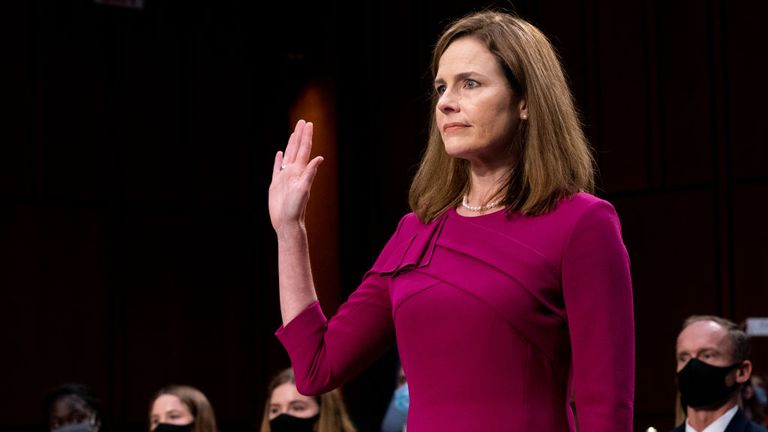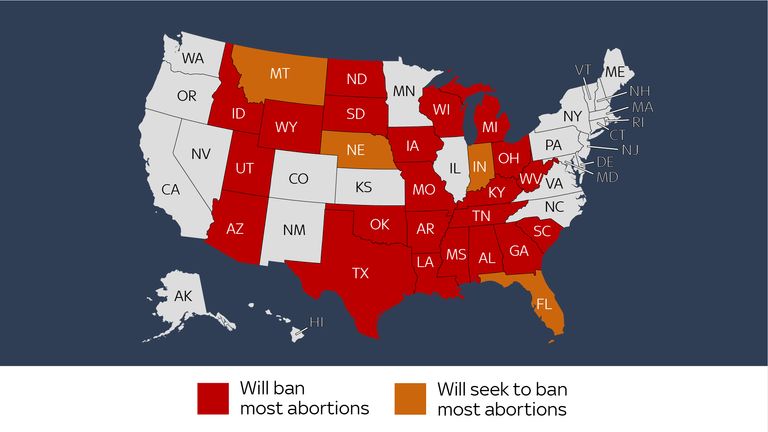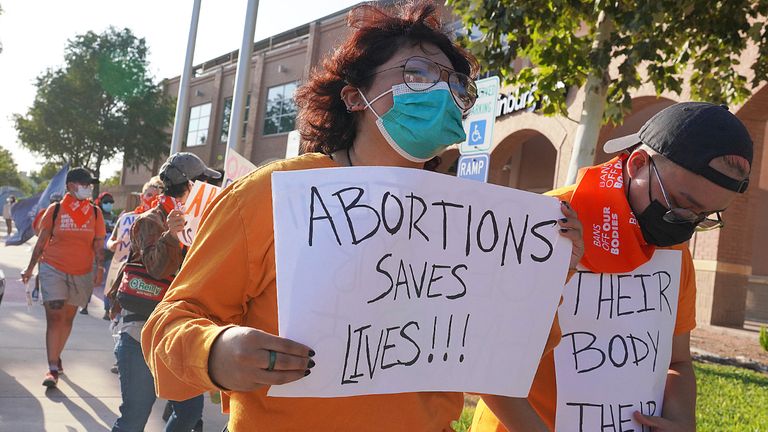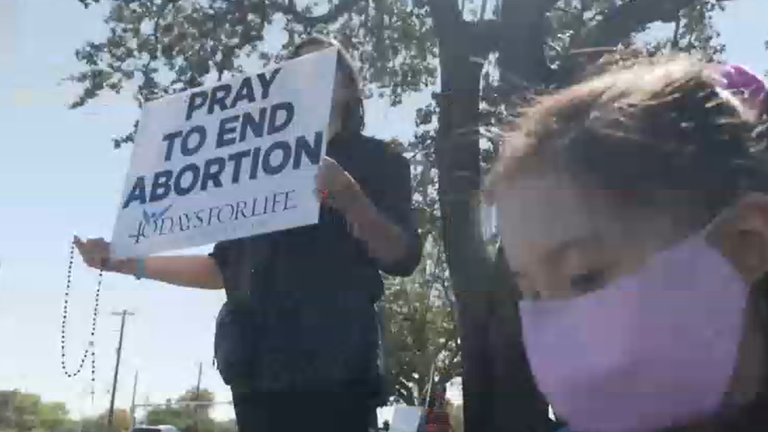[ad_1]
A leaked document that suggests the US Supreme Court could move to abolish the constitutional right to an abortion has been branded a “disgrace” and “the greatest restriction of rights in 50 years”.
Late on Monday Politico published a draft ‘opinion’ on abortion rights written by the Conservative Supreme Court Justice Samuel Alito which describes the landmark 1973 case Roe v Wade as “wrong from the start”.
He adds: “We hold that Roe and Casey [another fundamental abortion case] must be overruled.”
Although Chief Justice John Roberts has confirmed the document’s authenticity, he has said it “does not represent a decision by the court or the final position”. It is also not known if amendments have been made since it was written in February.
But should it pass, at least 22 US states could introduce bans on abortion.
What is Roe v Wade?
Roe v Wade was the landmark case of a Texan woman, Norma McCorvey, who was referred to by the legal pseudonym of Jane Roe to protect her privacy.
In 1969 she became pregnant with her third child and was unable to get an abortion because the state only allowed them if the mother’s life was in danger.
Her lawyers brought a case against the local district attorney Henry Wade to the US Federal Court, claiming Texan abortion laws were unconstitutional.
The District Court for the Northern District of Texas ruled in her favour, but Mr Wade appealed the decision at the Supreme Court.
After hearing the arguments, in 1973 the court revealed seven of its nine justices had voted in favour of Ms Roe.
This meant a change to the constitution and that regardless of any state laws banning abortion, every woman in the US has the right to one within the first 12 weeks of pregnancy – and some rights to one beyond that.
Without the protection of the 1973 ruling, abortion laws would be decided at state level.
What does the leaked Supreme Court document show?
The Supreme Court is currently presiding over the case Dobbs V Jackson Women’s Health Organization, which argues the 2018 Mississippi state ban on abortions after 15 weeks is unconstitutional.
The case cites both Roe v Wade and another key piece of US-wide abortion legislation – Planned Parenthood v Casey from 1992.
That case saw five criteria of Pennsylvania’s Abortion Control Act (1982) overturned by the Supreme Court.
Justices ruled that the required waiting period, the need to inform the woman’s spouse, and parental consent for minors were “undue burdens” on women seeking abortions up to 24 weeks.
The leaked ‘draft opinion’ written by Justice Alito reads: “Roe was egregiously wrong from the start. Its reasoning was exceptionally weak, and the decision has had damaging consequences.
“And far from bringing about a national settlement of the abortion issue, Roe and Casey have inflamed debate and deepened division.”
Read more:
Activists chant ‘do something Democrats’ as they protest outside US Supreme Court over leaked draft ruling
Mississippi case will have ripple effect across the US
New law forces Texan women to travel outside state for abortions
How does the US Supreme Court work and could it mean the draft becomes law?
The draft, now confirmed as authentic by Chief Justice Roberts, was written in February, with a final decision on Dobbs v Jackson not due until early July.
Under the US system, the Supreme Court is made up of nine Supreme Court justices, who hear fewer than 1% of the cases it is sent every year.
The justices are appointed by presidents and can serve until they die, meaning the political leanings of the court can be different to the White House.
Currently there are six justices appointed by Republican presidents and three by Democrats.
During Donald Trump’s presidency, he appointed three new Republican justices, notably replacing Ruth Bader Ginsburg, a champion of women’s rights, with Amy Coney Barrett – a staunchly Conservative Catholic.
Mara Clarke, the founder of Abortion Support Network (ASN), has been campaigning to protect women’s abortion rights for more than 20 years.
She tells Sky News: “Despite the fact that the majority of people in the US claim to be pro-choice, the opposition to abortion is baked into the political framework.
“Things were hard when I started doing this work 20 years ago, but we all knew the shift in the Supreme Court would be the death knell.”
After hearing oral arguments on both sides, the nine justices deliberate and vote, before one on the winning side is appointed to draft an ‘opinion’ that sums up their ruling.
This can be edited several times before the opinion is published and becomes the ‘opinion of the court’ and therefore constitutional law.
The leak reveals five of the six Republicans to be in favour of repealing Roe v Wade, but it is not clear how the sixth, Chief Justice Roberts, will vote.
A leak of this kind has never happened before in the history of the Supreme Court, with the Marshal of the Court now investigating to find the source.
So although it could have since been amended to remove sections on Roe v Wade, the unprecedented nature of the leak and the court’s decision to consider the constitutionality of Roe v Wade in the first place has sparked fears among campaigners the draft will pass.
“If they don’t get it this time, they will just keep pushing for it,” Ms Clarke adds.
“It has been a long fight and it will continue to be a long fight.”
Which states could ban abortion if Roe v Wade is overturned?
Abortion has always been a divisive issue in the US.
Ms Clarke says: “There a lot of people who think the issue of legal action against abortion in the US is new – it isn’t.
“This is horrifying, rage-inducing and disgusting, but is it surprising? No.
“If you look at how many pieces of anti-abortion legislation are passed each year, it’s likely to be more than any other type of law.”
Some states have one or no abortion providers, she adds, and there are also TRAP (targeted regulation of abortion providers) laws in some that make it near impossible and financially unviable to operate and access clinics.
This makes the US-wide protection of abortion rights in Roe v Wade all the more important.
If the 1973 ruling is overturned or fundamentally weakened by any new changes, 22 of 50 states have either their own laws or constitutional amendments that would allow them to ban abortion as soon as possible.
These include laws that banned abortion before Roe v Wade and were never removed, ‘trigger’ laws that would automatically take effect if Roe v Wade is removed, near total-bans on abortion currently blocked by Supreme Court orders, six and eight-week abortion bans, and amendments to state constitutions that block protected abortion rights.
A further four states – Florida, Indiana, Montana and Nebraska – have taken legal action against abortion in recent years, similar to last year’s ban in Texas – that strongly indicate they will enforce their own bans as soon as constitutional protections are gone.
On the other side, Sixteen states and Washington DC have their own laws that protect abortion rights beyond the 1973 ruling, which means abortions there will remain legal.
These include California, New York, Oregon and Washington.
But the remaining eight have not yet made their position clear, with states such as Kansas and North Carolina likely to vote against it.
What would it mean for American women?
This week’s leak has triggered mass protests outside the Supreme Court and across the US.
Democrats such as Hillary Clinton have said overturning Roe v Wade would “kill and subjugate women” and branded it an “utter disgrace”.
Senate Majority Leader Chuck Schumer and House Speaker Nancy Pelosi said in a joint statement it would be the “greatest restriction of rights in the past 50 years”, an “abomination” and “one of the worst and most damaging decisions in modern history.”
Ms Clarke, whose organisation helps fund women who need to get abortions abroad, stresses that 90% of US counties do not have a single abortion provider, some doctors cover several states by themselves and others conscientiously object.
“For many years already low-income and marginalised people have depended on abortion funds to access them,” she says.
And despite a change in World Health Organisation (WHO) advice that endorses take-at-home abortion pills as the safest way to end a pregnancy up to 12 weeks, women all over the world still resort to dangerous and deadly last resorts.
“People are still Googling ‘can I do this to have an abortion?’,” Ms Clarke adds.
“When I started working on this in the UK before there was widespread knowledge about abortion pills, one mother tried to crash her car – but not die – to induce an abortion.
“Another had never done drugs in her life but thought if she tried heroin the shock to her system would work.”
Follow the Daily podcast on Apple Podcasts, Google Podcasts, Spotify, Spreaker
But she says the US network of around 90 groups and independent abortion providers will continue helping women access abortions privately.
“There would be extreme chaos if this happens, but those groups will continue funding people’s abortions. They pay for procedures, have drivers, pay for hotel rooms, put people up in their own homes.
“For those who are just waking up to this problem, welcome, we are tired, and we could use some help.”
She also says that abortion pills, which have been legalised in the UK after being used as an emergency measure during the pandemic, are going to “save thousands of lives” across the US should the legal changes go through.
“But this also isn’t just a US problem – it’s a global problem,” she adds.
“UK abortion laws are by no means perfect – people in Scotland still have to travel to England if they are more than 18 weeks pregnant.
“It’s really easy to point fingers and laugh at backwards Americans, but I would urge people to look at themselves and their neighbours too.”
[ad_2]









